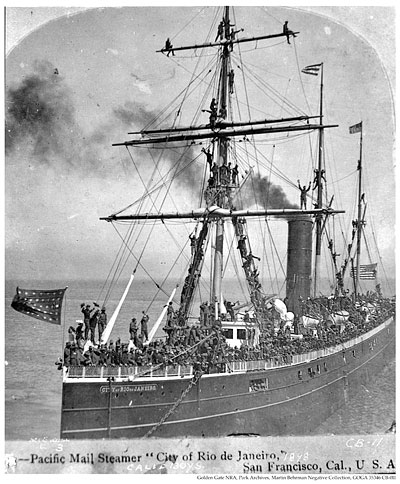National Register of Historic Places in San Francisco
 "California Boys Aboard the City of Rio de Janeiro in 1898"
"California Boys Aboard the City of Rio de Janeiro in 1898"
Photo Courtesy Golden Gate National Recreation Area Archives
(Click Photo to Zoom)
Shipwreck of SS City of Rio de Janeiro Mail Steamer
Address Restricted
The SS City of Rio de Janeiro was an iron hulled steam powered passenger ship, launched in 1878, which sailed between San Francisco and various Asian Pacific ports.
On 22 February 1901, while trying to pass through the Golden Gate in heavy fog, en route to her home port of San Francisco, the ship struck rocks, reportedly on the southern part of the straits at or near Fort Point, and sank.
The damage was considerable: virtually the entire underside of the vessel had been torn open by the collision and the engine room and cargo holds rapidly flooded. The ship had been built in 1878, before watertight bulkheads came into use, and sunk in 320 feet of water only eight minutes after striking the reef.
Launching of the lifeboats was hampered by a language barrier between her mostly Chinese crew and American officers.
The wreck was so sudden that the lookout at the Fort Point Lifesaving Station, only a few hundred yards away, was completely unaware of the situation for two hours, when a lifeboat was sighted emerging from a fog bank. Fortunately Italian fishermen were nearby and were able to rescue a number of survivors clinging to wreckage.
Of the 210 people aboard, 82 were rescued and approximately 130 people perished. The captain, William Ward, was not among the survivors. He had previously stated that if ever faced with such a situation, he would go down with his ship.
Divers engaged by the Pacific Mail Line immediately began a search for the ship but failed to find any traces of it due to the depth of the water in the area, well beyond the diving or salvage capabilities of the time.
For some years after the disaster, bodies washed up on the beach near Fort Point, including, in 1903, the remains of Captain Ward which were identified by the watch chain wrapped around his rib cage. In 1917, a wooden keg clearly marked Rio de Janeiro surfaced off Point Lobos. In 1919, more wreckage from the ship surfaced off Suisun Bay, forty miles away from the assumed site of the wreck between Mile Rock and Baker Beach.
In 1931 a Captain Haskell announced to a news conference that he had discovered the wreck using a two-man submarine of his own invention and that he planned to salvage six million dollars worth of silver from the wreck.
Captain Haskell disappeared without a trace in July 1931.
The wreck of the SS City of Rio de Janeiro has not been located. Some say that the currents off Baker Beach are too strong for amateur divers and the water is too deep. Some say that currents pushed the ship out to sea as she sank. Some say that because so many ships have perished in the Golden Gate, she will never be found; even modern sonar cannot distinguish whatever remains of the SS City of Rio de Janeiro from all the other disintegrated remnants of sunken ships.
Source: Wikipedia entry for SS City of Rio de Janeiro
